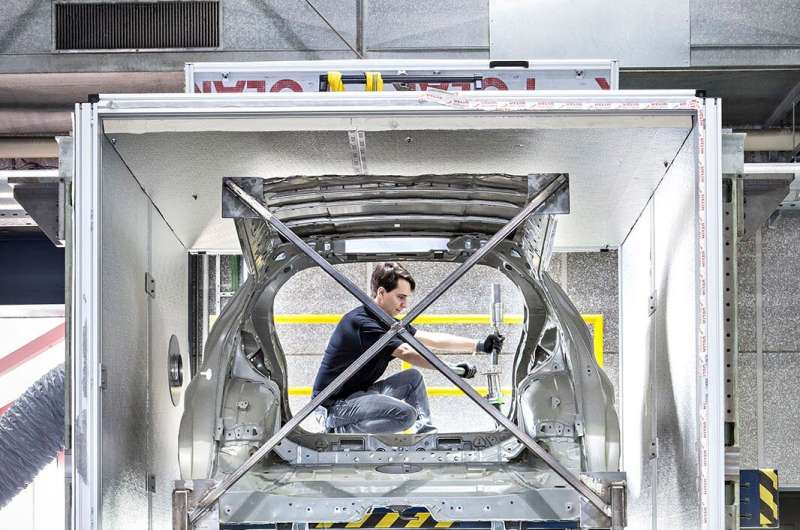The researchers at Fraunhofer LBF designed a custom cell for testing the newly developed lightweight components’ structural durability. Credit: Fraunhofer LBF, Raapke
Lightweight technology has long been and is sure to remain a mainstay of automotive and aerospace engineering, shipbuilding and a host of other industries. Lighter materials and components could also help cut emissions that drive climate change. But lighter options are pricier, and the relatively steep cost has impeded their adoption. That is about to change thanks to the efforts of a consortium of automakers, suppliers and research institutes. Called ALLIANCE and coordinated by Daimler and the Fraunhofer Institute for Structural Durability and System Reliability LBF, this project has some good news for designers: As it turns out, it is entirely possible to build components that are up to 33 percent lighter at an added cost of less than three euros per kilogram-saved.
If we want to tackle climate change, we will have to curb cars' harmful emissions. One way to do this is to build lighter vehicles. Automakers have been slow to go down that road because lightweight components are pricey. They are simply too expensive for budget models. If lightweight designs are to go mainstream and make up the majority of installed components, engineers will have to find a way to driving prices down.
CO2 emissions slashed by 25 percent
This is exactly what the numerous partners engaged in the EU's AffordabLe LIght-weight Automobiles AlliaNCE project—or ALLIANCE for short—set out to do. They sounded out the potential for savings and developed technologies to seize the most promising opportunities. Six major automakers, six component and material suppliers, and various research institutes took part in this project coordinated by Daimler and the Fraunhofer Institute for Structural Durability and System Reliability LBF in Darmstadt. "Together, we were able to establish that cost-effective lightweight design is feasible," says Prof. Thilo Bein, Head of Knowledge Management at Fraunhofer LBF. As the designated project secretary, he liaised among partners, tracked results, organized meetings, and the like. "We managed to make individual components more than 30 percent lighter, thereby reducing their share of CO2 emissions by 25 percent—with per-component costs increasing just €2.67 per kilogram-saved on average, which is acceptable for automakers." This project's protagonists found that costs can be even lower if the CO2 and energy balances are factored in from the outset.
Design first, joining last
The scientists at Fraunhofer LBF did more than merely help coordinate the project. They also brought their research skills to bear in the components' design. Engineers have to optimize from the bottom up all new materials in car parts. They fine-tune these components' weight, the thickness of their walls, and their natural frequencies, which are important to managing noise, among other parameters. They often use the finite-element method to this end. Take, for example, a fender. Its designer would first create a virtual model, and then divide it into many small units to calculate and optimize this part's physical behavior. The downside to these models is that they are terribly complex. "This is why we developed a parameterized model at Fraunhofer LBF that simplifies this procedure enormously," says Bein. These experts streamlined the model, reducing its complexity yet retaining parameters such as weight, natural frequency or wall thickness. This simpler model serves to optimize parameters, which are then funneled back into the original finite-element model. "This multi-parameter optimization may be used both in the early conceptual phase and later when detailing the design," says Bein. Testing their method on a virtual demonstrator module for an Opel front-end component, the researchers found it to be a big help: it enables components to be designed with fewer iterative steps and provides a better way of achieving target parameters.
Joining methods were also on the ALLIANCE project's agenda. These were to connect lightweight components in a secure and firm manner. The development effort identified 14 different suitable joining processes. Fraunhofer experts brought their specific knowledge to the table when it came time to test for structural durability. Tasked to investigate hybrid joining processes that combine rivets with adhesive bonds, they subjected component-like samples to various cyclical loads to determine how well joints would hold up to wear and tear. Fraunhofer LBF researchers also tested a plastic Toyota underbody for structural durability. The results of both tests were good.
This project has run its course, but the consortium decided to branch out its research, so a follow-up project is in the pipeline. "The results will flow into product development over the next few years," says Bein, speaking with assurance.
Provided by Fraunhofer-Gesellschaft
























